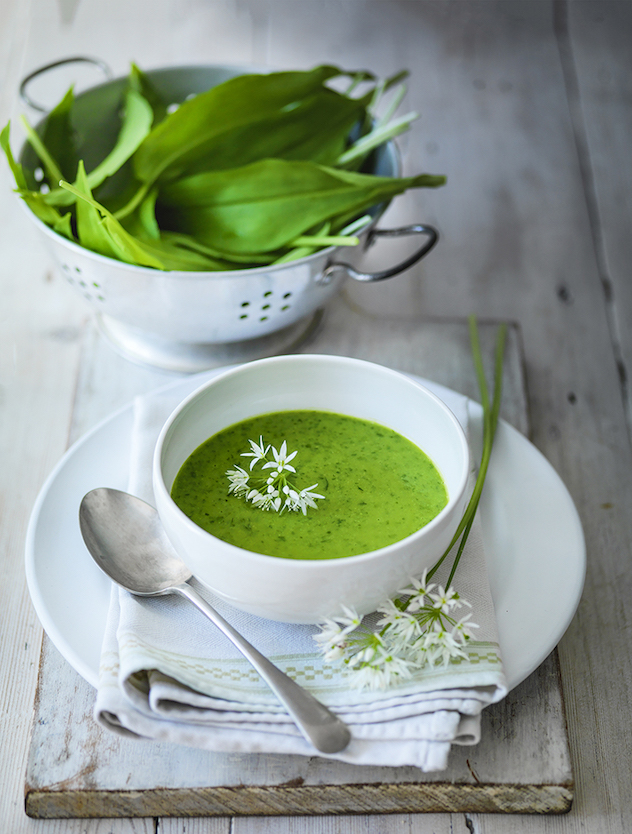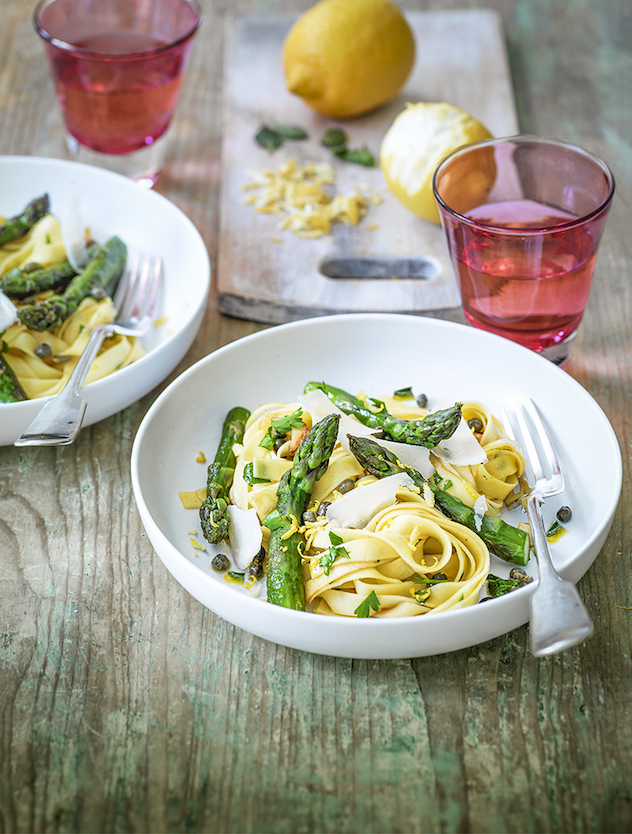Five mouth-watering summer recipes thanks to The Summer House.
Watercress, Cucumber & Celery Green Juice
Serves 2
This healthy appetite booster is a great start to any meal, and also aids digestion.
Large handful of freshly picked watercress
1 English cucumber, cut in half
2 medium sticks of celery
1 lime, zest and pith removed
1 green apple, cut into wedges
1 small thumb of ginger
6 ice cubes
Chop the watercress, cucumber, celery, lime, apple and ginger, and place them all in a powerful blender. Add the 6 ice cubes and blend until the ice is completely crushed. Pass through a fine-mesh strainer, give a good stir and serve immediately.

Wild Garlic, Pea & New Potato Soup
A really tasty soup that uses only the freshest spring ingredients. Wild garlic or onion weed grows abundantly in New Zealand and is considered by some to be an invasive weed – however, the stalks and leaves have a wonderfully fragrant mild garlic and spring onion flavour and make a delicious pesto. The flowers can also be added to salads and the bulbs can be used like garlic. One important tip – make sure you only use small, new-season potatoes in the soup to get the best results, and ensure they are cooked right through before blending.
Serves 4
75g shallots, peeled and chopped
1 tbsp olive oil
400g new potatoes, peeled and chopped
1L chicken or vegetable stock
200g young garden peas (you can also use frozen peas)
75g wild garlic leaves, washed and chopped
Wild garlic flowers, to garnish
Fry the shallots in the olive oil for about 2 minutes, stirring occasionally, then add the potatoes and toss until well-coated. Cover and sweat on a gentle heat for about 10 minutes. When the shallots and potatoes are almost soft but not coloured, add the stock. Bring almost to the boil and cook until the potatoes and shallots are soft. Season to taste with salt and plenty of freshly ground pepper
Add the peas and the wild garlic leaves and simmer with the lid off for about 2-3 minutes, or until both the peas and the wild garlic are cooked. Do not overcook or the soup will lose its fresh green colour. Puree the soup using a hand blender.
Taste and adjust seasoning. Serve garnished with a few wild garlic flowers.

Goat’s Cheese & Baby Spinach Frittata with ‘Spring’ Pesto
A simple Italian frittata that’s perfect for a light lunch or snack, and is also great to take on a picnic. It can be served warm from the pan or cold with a spring watercress salad. As the frittata uses goat’s cheese there’s no parmesan in the pesto.
Serves 4
FRITTATA
8 free-range eggs
2 tbsp olive oil
8 spring onions, roughly chopped
100g baby spinach leaves
A squeeze of lemon juice
125g soft goat’s cheese, cut into 1cm pieces
PESTO
1 garlic clove
A big bunch of fresh basil
A big bunch of flat-leaf parsley
Handful of pine nuts, lightly toasted
2 tbsp extra-virgin olive oil
A squeeze of lemon juice
To make the pesto, peel the garlic and use a mortar and pestle to pound it with a small pinch of sea salt. Roughly chop the basil and parsley leaves and add to the mix, then pound to a paste (you can also pulse in a food processor).
Add the pine nuts to the mixture and pound again. Drizzle in some oil – you need just enough to bind the pesto and get it to an oozy consistency. Season to taste with salt and black pepper, then add a small squeeze of lemon juice to give it a little zing.
To make the frittata, crack the eggs into a large mixing bowl. Lightly whisk with a generous amount of salt and pepper.
In a small, heatproof frying pan, heat the olive oil and sauté the spring onions until soft. Meanwhile preheat the grill to medium-high heat. When the spring onion is translucent, add the spinach gradually and cook until wilted, then give everything a good stir. Add a little extra oil, a pinch of salt and the lemon juice. Top the spinach mixture with the goat’s cheese.
Turn the heat to medium and pour in the eggs, making sure the mixture fills the pan evenly. Cook for 4-5 minutes or until the sides have started to set.
Transfer the pan to the grill and cook for another 4-5 minutes, or until the frittata is golden and puffed up slightly. Shake the pan gently to check for the set – if it still looks runny, return to the grill for a few more minutes. Carefully remove from the grill and use a palette knife to release the sides. Slide the frittata onto a plate or board and serve in wedges topped with the pesto. Delicious with a fresh watercress salad.

Tagliatelle with Green Asparagus, Fresh Herbs & Lemon Zest
This Italian classic is a great way to enjoy young asparagus picked fresh from the garden. I have eaten it at Easter at a friend’s house in Sicily when the lemons that ripen over the winter are at their best and the young herbs are really bursting with flavour. The secret is to use the freshest of lemons – ideally just picked. And don’t be afraid to use lots of olive oil.
Serves 2
3 tbsp extra-virgin olive oil
1 garlic clove, crushed
1 big bunch asparagus
500g fresh tagliatelle pasta
A handful of chopped flat-leaf parsley and oregano
1 tbsp capers
1 lemon, zest and juice
Parmesan cheese, to serve
Heat the olive oil in a shallow frying pan with a lid, and fry the crushed garlic to infuse the oil. Cut the asparagus stalks in half and add the tops to the pan. Cook with the lid on until just tender (you can keep the other half of the asparagus for soup). In a saucepan of boiling water, cook the tagliatelle for 3-4 minutes or until just al dente. Drain well, and then add the tagliatelle, chopped herbs, capers, and lemon zest and juice to the asparagus in the shallow pan and drizzle with some extra olive oil. Toss together, then season with salt and freshly ground black pepper and cook for another minute. Serve sprinkled with shaved Parmesan.
Rhubarb & Ginger Crumble
Quintessential English rhubarb is at its best in the spring when the stalks are pink, small and tender. It tends to shrink down when cooked, so pile it high in your baking dish. For the perfect crunchy crumble texture, ensure your butter is really cold and keep the crumble loose when covering the filling rather than pressing it down. You can make the crumble mix in advance and keep it in the fridge or freezer. Serve this dish with vanilla custard or even cold with Greek yoghurt the next day.
Serves 4
FILLING
700g rhubarb
1 vanilla pod or ½ tsp vanilla paste
75g Demerara sugar
2 tsp cornflour
1 tsp grated ginger
CRUMBLE TOPPING
150g cold unsalted butter, plus extra for greasing the dish
75g plain flour
50g brown sugar
150g jumbo oats
75g almond meal
30g almond flakes
Preheat the oven to 200ºC. Grease an ovenproof dish with a little butter.
To make the crumble, cut the butter into cubes, then put all the ingredients except for the almond flakes into a large bowl. Use your fingertips to rub the butter into the dry ingredients, until the mixture is lumpy but fairly well combined. Place in the freezer to cool for 5 minutes.
Chop the rhubarb stalks into 3cm pieces, halving any thicker pieces lengthways (peeling rhubarb is unnecessary). Halve the vanilla pod lengthways, scrape out the seeds and toss together with the rhubarb, sugar, cornflour and ginger. Pack down the rhubarb into the prepared baking dish.
Spread the crumble mixture over the rhubarb without pressing down. Place on a baking tray to catch any drips, then bake for 35-40 minutes or until golden and bubbling. Sprinkle the almond flakes over the top in the last 10 minutes of baking. Serve with lashings of hot vanilla custard.





